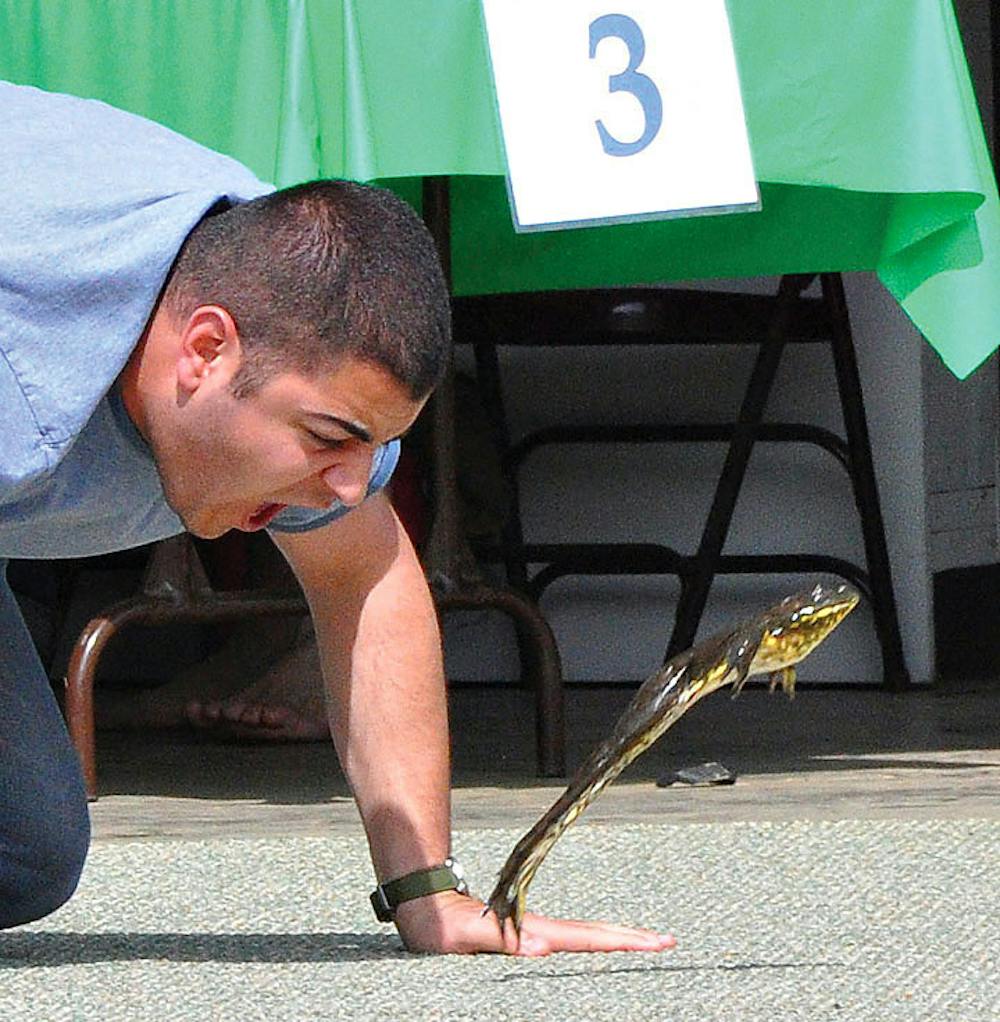At the Calaveras County Jumping Frog Jubilee in California — made famous in Mark Twain’s short story “The Celebrated Jumping Frog of Calaveras County” — three researchers discovered potential flaws in the study of the maximal jumping performance of bullfrogs, lending insight into why Jubilee bullfrogs have been out-jumping laboratory bullfrogs for years.
Richard Marsh, adjunct professor of ecology and evolutionary biology, Thomas Roberts, associate professor of ecology and evolutionary biology, and lead author Henry Astley, a postdoctoral researcher at the Georgia Institute of Technology, published their findings Oct. 16 in The Journal of Experimental Biology.
In the International Frog Jump, the “signature event” of the Calaveras County Fair, both professional frog jockeys and community members can pit their amphibious contestants against one another to see whose frog jumps the farthest, according to the fair’s website.
The research team’s interest in the frog jumping contest in Calaveras County was piqued when Roberts noticed a frog jumping record that he thought was a typo, Astley said. According to the fair’s website, a bullfrog named “Rosie the Ribiter” set the world record jump of 21 feet, five and three quarters inches in 1986. The researchers originally viewed the record with skepticism because “as scientists we tend to dismiss or take things lightly that are in the popular literature because they haven’t been done under lab conditions,” Marsh said.
“It was one of these nagging things where for years we kept wondering whether or not these records could be accurate,” he added.
Marsh said his interest in the contest is both personal and professional. “My interest in frog jumping dates back quite a number of years because I was interested in maximal muscle performance,” he said.
The researchers decided to attend the Frog Jubilee to study the bullfrogs’ extraordinary jumping abilities in the setting of the contest. In Calaveras, the frogs have a “huge stage” and professional frog jockeys behind them, Marsh said. To record their data, Astley organized a system to digitally capture the frogs’ jumps.
Attending the competition gave the researchers several ideas about motivating and measuring frog performance in their own research, researchers said.
“We had in all of our work been previously assuming maximal performance,” Astley said.
The contest was an especially useful context for the researchers to make their measurements, because “a lot of times in the lab we have a very stereotyped setup because we’re trying to film the animals and have a constrained space,” Marsh said. In these constrained conditions, the bullfrog cannot jump to its maximum capability, he added.
The implications of this study are widespread, as biologists use maximal performance to study evolution, Astley said. He added that this kind of research allows scientists to understand the physiological big picture, including “bones and nervous system functioning as one,” allowing them to infer how those components relate.
The team’s project should also provide some direction for how researchers evaluate maximal performance in future animal studies, Astley said. He added that the most important factor in determining how far the bullfrogs jump is motivation, which is difficult to instigate in laboratory settings.
Motivating frogs to jump can be a difficult challenge for frog jockeys, too. One technique is temperature regulation. Because there are optimal temperatures for muscle performance, frog jockeys “carefully warm their frogs and keep them in these special pockets with warm water,” Marsh said.
Another technique jockeys use to optimize performance is to scare the frogs, because wild bullfrogs jump optimally when they are frightened and escaping from predators.
At the competition, the team noticed a difference in the performance of frogs rented from the fair and frogs owned by frog jockeys. Astley and Marsh noted that though the competing frogs jump much further than the frogs available for rent, the differences were more situational than physiological.
“We consider it unlikely that there’s something physiologically different about the frogs. The rental frogs are kept at cooler temperatures before the competition, and frog renters may be novices when it comes to imitating predators to get their frogs to jump, Astley said.
“There are some early days of competition where it’s mostly citizens with rental frogs, so there’s a sparse audience,” Marsh said, “but when it comes down to the finals, the stands are full and people are cheering, and it’s really like a sporting event with frogs.”
The competitiveness with which competing teams engaged in the contest “was a bit surprising,” Marsh said.
“People take it very seriously,” he added.
Despite the professional interests of the researchers, Marsh and Astley commented on the humor of participating in a bullfrog jumping contest. Astley recalled a comic scene in which the sheets of paper the researchers had been using as a grid for their measurements were taken by the wind, prompting the researchers to buy out the local Home Depot of PVC pipes and construct a new, heavier grid. Marsh said the most humorous aspect of the event was “when the group of scientists out there doing this study had their turn at jumping frogs on the stage.” He added that his frog only jumped once before sitting in place, while Roberts’ frog went backwards toward the judges.

ADVERTISEMENT




